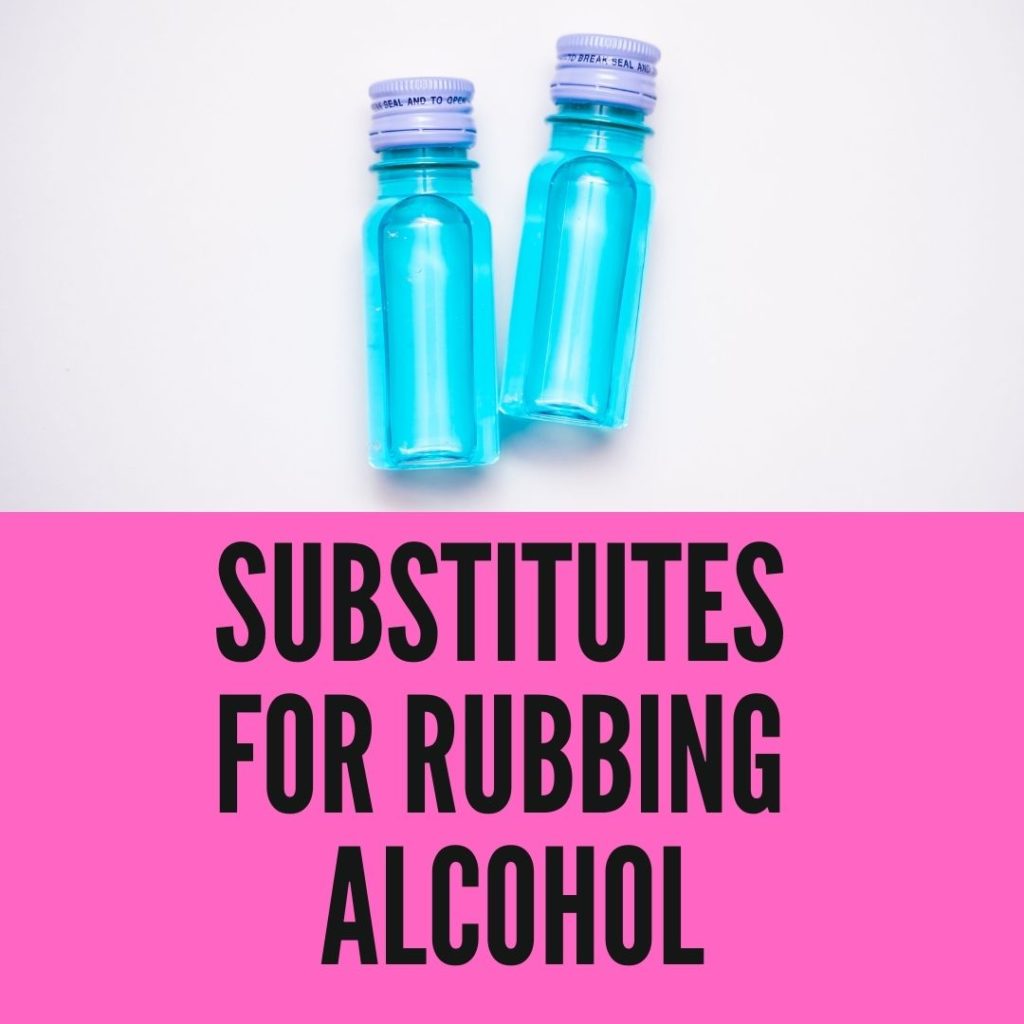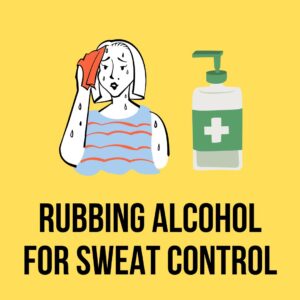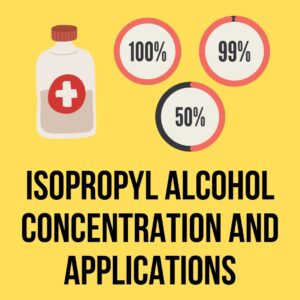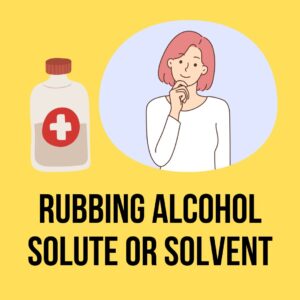Rubbing alcohol is a versatile distillate that can be used for a wide range of applications, but what if you can’t get your hands on any? Ever since the COVID-19 Pandemic began, rubbing alcohol has been in short supply worldwide as more and more of it is used to create hand sanitizer.
So what can you use as a substitute for rubbing alcohol? Soap and water, white vinegar, and bleach are the best substitutes for rubbing alcohol for cleaning surfaces. For wound disinfection, something like hydrogen peroxide is the best alternative to rubbing alcohol.
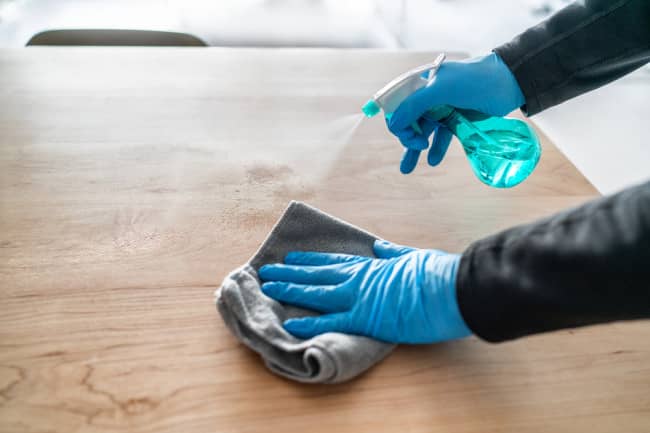
Throughout this guide, I’ll take a closer look at everything that rubbing alcohol can be used for, and I’ll list out alternatives that work well for that particular application.
I’ll also answer a few pressing questions about rubbing alcohol, including elaborating on the various types that are on the market.
Rubbing Alcohol Substitute Table
Here’s a list of the things you can use to replace rubbing alcohol, organized by their function:
| Rubbing Alcohol substitute | What it can be used for |
| White vinegar | Cleaning, disinfecting |
| Bleach | Cleaning, disinfecting |
| UV light sanitizers | Cleaning, disinfecting |
| Lysol | Cleaning, disinfecting |
| Distilled spirits | Cleaning, disinfecting, sanitizing wounds |
| Hydrogen peroxide | Sanitizing wounds |
| Witch hazel | Sanitizing wounds |
What Can You Use Instead of Rubbing Alcohol?
If you don’t have to rub alcohol at your disposal, you’ll have to define what you intend to use the rubbing alcohol for before you can find a replacement for it.
Unfortunately, not all of the available replacements are as versatile as rubbing alcohol, with most of them exhibiting more specialized qualities.
Here are some of the things that rubbing alcohol can do:
- Disinfect surfaces
- Clean out wounds
- Decreasing body odor
- Degreasing
These are just a few of the tasks that rubbing alcohol can accomplish, so you’ll have to pick out a few of them and then find individual replacements for these tasks.
Isopropyl alcohol is a very potent substance that can cause serious illness if ingested. If you are going to use it for cleaning or any other purpose, it is important to know how to dilute the 99% concentration appropriately so that you don’t get sick and your skin doesn’t dry out.
Are you wondering how to dilute 99% isopropyl alcohol to 70%? To dilute 99% isopropyl alcohol to 70%, you can add the correct proportion of water to 99% isopropyl alcohol and convert it into 70% isopropyl alcohol. If you want to make 1 liter of 70% Isopropyl alcohol, take 700ml of 99% isopropyl alcohol and add 300ml of water to it.
For example, if you want to clean up around the house, then one of the more suitable replacements for rubbing alcohol would be white vinegar.
On the other hand, if you need to use something to disinfect your wounds, you’ll want to use hydrogen peroxide.
Since there are so many potential replacements for rubbing alcohol based on the application, let’s take a look at them one by one.
“As an Amazon Associate, I earn from qualifying purchases.”
1. White Vinegar
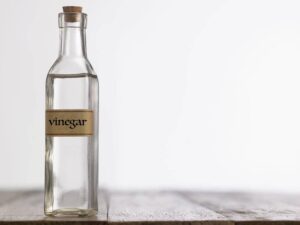
You may have heard stories about the cleaning powers of white vinegar, and while they may have been blown slightly out of proportion, it’s still one of the safest, most effective ways to clean out your home.
White vinegar works so well when it comes to cleaning things because it contains acetic acid that resulted from the fermentation process.
This acid eats through dirt and grime and helps destroy grease, making it excellent for household cleaning tasks, especially in the kitchens or bathrooms.
One of the best things about white vinegar relative to rubbing alcohol is that it’s edible. You can drink a cup of white vinegar, and while it wouldn’t be a pleasant experience, it won’t result in immediately debilitating side effects like rubbing alcohol.
For this reason, white vinegar is a popular choice of cleaner or disinfectant for families that have small children in the home.
You’ve likely seen how children have a penchant for putting nearly anything in their mouths, and the last thing you want them doing is ingesting rubbing alcohol.
Another great thing about white vinegar is that it can help take over rubbing alcohol when it comes to maintaining your skin’s health.
If you rely on rubbing alcohol to reduce itchy sensations from rashes or poison ivy, then you can turn to white vinegar and it will do exactly the same thing.
The anti-inflammatory nature of acetic acid also makes white vinegar effective at treating ear infections, but always be sure to discuss your treatment options with your doctor before doing so.
One of the main weaknesses of white vinegar is that it lacks many of the anti-viral properties of rubbing alcohol, meaning that it’s not effective at stopping the transmission of viruses through surfaces.
If you’re trying to sterilize your surroundings in the midst of the COVID-19 pandemic, you may want to avoid white vinegar.
2. Bleach
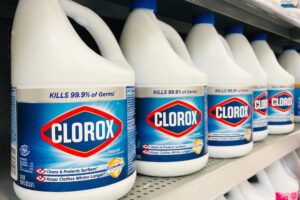
While bleach is a lot more dangerous than white vinegar due to its high toxicity, that very characteristic also makes it more effective at killing viral pathogens and other organic threats.
Whereas vinegar will struggle to kill more resilient organisms, bleach has no problem destroying those threats.
Of course, you’ll never want to use bleach on your body like you use rubbing alcohol because of how toxic it is.
However, if you’re looking for the most effective surface sanitizer that you can use as an alternative to rubbing alcohol, then you’ll struggle to find something as effective as bleach.
As long as you’re careful while handling it, even a small amount of bleach can disinfect a large area just because of how potent it is.
Most cleaning solutions use a ratio of one tablespoon of bleach per gallon of water, but this isn’t powerful enough to fully disinfect surfaces.
On the other hand, if you’re trying to disinfect and kill even the most resilient pathogens, you’ll have to increase the ratio of bleach to about ¾ of a cup per gallon.
Bleach is similar to alcohol in that it doesn’t remain on the surfaces that you clean for a long time, making it relatively safe for household use.
Where rubbing alcohol begins to evaporate as soon as you clean with it, bleach will start breaking down after it spends a few hours on the surface that has been cleaned.
In the meantime, be sure that no one touches or uses the cleaned surface to make sure that they aren’t accidentally exposed to the bleach.
- DISINFECTANT SPRAY: Use this Clorox Clean-Up Disinfectant Cleaner with Bleach Spray to clean and disinfect, killing 99% of bacteria and viruses, including cold and flu
- MULTI-SURFACE CLEANER: This all in one Clorox bleach spray cleans, disinfects and deodorizes surfaces in high traffic areas including commercial kitchens, restrooms and other business facilities
- BLEACH CLEANING SPRAY: Powerful all-purpose cleaner with bleach removes tough stains, grease and grime and eliminates odors caused by bacteria, mold and mildew
- KILL VIRUSES: This spray cleaner eliminates messes and germs; meets EPA criteria for use against virus
- GREAT FOR COMMERCIAL USE: From CloroxPro, this disinfectant spray cleaner is ideal for use in offices, day care centers, restaurants, schools and other commercial facilities
3. UV Disinfecting Light
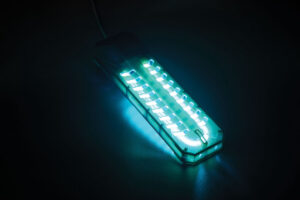
A specific type of UV light, known as UVC (Ultraviolet C), has been used in hospitals to disinfect places like surgery theaters for years.
With the beginning of the COVID-19 pandemic, UVC sanitizers have entered the spotlight as a relatively efficient way to disinfect rooms.
While UVC can’t be used on your skin, as ultraviolet light has been proven to cause various skin cancers, you can use it to destroy any bacteria or viral pathogens that are lurking in your home.
There are a few advantages to using a UV disinfecting lamp, especially in hospital settings.
Certain bacteria and pathogens can develop a resistance to methods that are used to kill them, and this is the underlying theory behind the “superbug” phenomenon.
As drugs and other methods are used to kill a certain kind of bacteria, they will eventually grow resistant to them.
On the other hand, pathogens have a much harder time growing accustomed to concentrated UVC light, which does an excellent job of eradicating them.
A further benefit to UV sanitizers is that they’re not finite. Since they’re electronic devices, these sanitizers can be recharged when they’re running low and then re-used to keep the area clean.
Due to the potential side-effects of UV light, anyone using a UV sanitizer to clean out an area will have to be particularly careful to avoid any lasting damage to their DNA.
These devices are best used by trained professionals to limit the risk associated with using them improperly and causing long-lasting side effects.
- ✿Safe Function: ➤The UV sanitizer lamp with Volatile ozone can kill up to 99.9% of most viruses, airborne bacteria, and mold spores.Uses UVC sterilizer light, 360 ° degrees wide beam angle.Made of quartz material, long service life, high transmission rate, and better sterilization effect.
- ✿Use safety:➤ It can be operated remotely through doors, walls, cabinets, etc. There is no limit on the angle, and you do not need to worry about being injured by ultraviolet radiation during operation. Use method 1: panel operation Use method 2: remote operation.
- ✿Applicable places&Usage:➤ UV deodorizer air freshener for home,Eliminates germs and mold for all season,It can safely used in houes, as well as in hospitals, laboratories, malls, doctors offices, commercial buildings, food processing plants and other commercial and residential environments throughout the world - any big area place a concern for clean air exists.
- ✿Very important:➤Exposing the Ultraviolet radiation for a long time will cause skin and eye burns, please pay attention to the Use instruction manual.People,pet animals and plants are Not Allowed to be present when the UV lamp lighting to work. Please leave away from the place of use immediately. To avoid damage to the skin and eyes, please DO NOT Stare at the ultraviolet light source.
- ✿Improving the air quality is essential to our life.There are odors, dust mites, mold spores, pollen, pet dander and more around our air environment.By UV sanitizer and air purify to reduce airborne germs in the homes.Model:ST-XD-01 EPA Est:NO.97237-CHN-1
4. Lysol
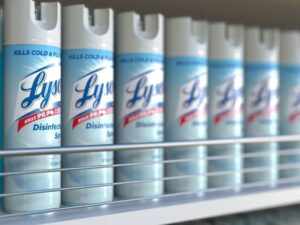
Yet another agent that you can use to sanitize surfaces, Lysol is one of the better-known options at your disposal, and it’s just as effective at eliminating bacteria as it is at killing viruses.
In fact, Lysol has a list on their site of the exact products that they produce that are capable of killing the COVID-19 virus.
One of the best things about Lysol is its versatility, as it comes in both spray and disinfectant wipes. Whereas the wipes are effective at wiping down specific surfaces like shopping cart handles, Lysol spray allows you to disinfect a large area in a much quicker amount of time.
Even better, when using Lysol spray, you won’t have to worry about touching anything that you’re disinfecting, reducing the chance of any germs or particles being spread around.
Of course, much like bleach and UV disinfecting, you won’t want to put Lysol anywhere near your skin for extended periods of time and it has none of the health benefits offered by rubbing alcohol.
- DISINFECTANT SPRAY KILLS 99.9% OF VIRUSES AND BACTERIA: Lysol Disinfectant Spray is tested and proven to kill 99.9% of viruses and bacteria, including COVID-19/Coronavirus* (when used as directed); EPA Reg #777-99.
- ANTIBACTERIAL BLEACH-FREE DISINFECTANT : this Lysol disinfecting product should work as hard as you do; this household disinfectant kills over 100 illness causing germs, including cold and flu viruses.** (**when used as directed).
- DISINFECTING SPRAY FOR GERMS: This disinfecting spray eliminates messes and 99.9% of germs and odor causing bacteria.Aluminum free
- SANITIZING SPRAY FOR HARD AND SOFT SURFACES : This fast-acting spray disinfects hard non-porous contact surfaces and sanitizes surfaces.
- LEADERS IN DISINFECTION: Looking for some of our other best household disinfectant cleaning products? Try Lysol Disinfectant Cleaning Wipes, Lysol All Purpose Cleaners, and Lysol Bathroom Cleaners (packaging may vary).
5. Distilled Spirits
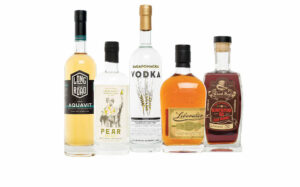
Why not replace rubbing alcohol with alcohol of a different variety? While distilled alcohol made for drinking may be available in lower concentrations than rubbing alcohol, it may be easier to find than its non-drinkable counterpart, and it makes for a decent alternative.
Keep in mind that the cleaning effectiveness of your drinking alcohol depends on its percentage.
Your typical 80-proof liquor will not be as effective at cleaning things as 99% ethanol rubbing alcohol, but it’s always possible to find more concentrated forms of alcohol like 160-proof rums and stronger Everclear.
Another advantage to distilled spirits over rubbing alcohol is that they’re drinkable, meaning that they’re safe to clean surfaces with.
Keep in mind that this kind of alcohol isn’t child-friendly to clean with, as it can harm any child that unwittingly licks it up, so try to avoid using it with young children in the house.
Spirits like vodka can even be used as an alternative cleaner to rubbing alcohol for electronics.
Drinking alcohol can even be used to treat itchy skin and rashes, much like rubbing alcohol, so it’s one of the more versatile options on this list.
A downside to using drinking alcohol for cleaning is that it tends to be much more expensive than rubbing alcohol because it has to be made safe for human consumption.
6. Hydrogen Peroxide
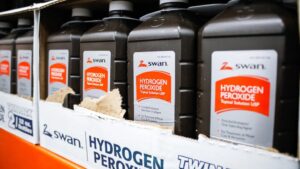
Hydrogen Peroxide, also known as H2O2, is a disinfectant that is commonly used alongside rubbing alcohol to treat wounds.
While you likely have both in your medicine cabinet, you only ever really need either one or the other at a time, so if you’re looking for a good way to keep wounds clean amidst a rubbing alcohol shortage, look no further.
Peroxide is easily identified by the bubbling it causes when it contacts your blood, but under that flashy show, the chemical works at eating away harmful bacteria that may enter your wound.
An advantage that hydrogen peroxide has over rubbing alcohol is that it doesn’t sting on application, making it a great choice for cleaning out children’s wounds.
Even though hydrogen peroxide is typically used to clean out wounds, it can also be used as a surface disinfectant in a pinch.
Its effectiveness at killing bacteria doesn’t stop if it’s not applied to your skin, so you can expect it to do a good job of killing bacteria on countertops and more.
One of the issues with using hydrogen peroxide for cleaning surfaces is that it’s often more expensive than alternatives like Lysol or bleach, so it may not be the most efficient option.
Regardless, if you have some peroxide in your medicine cabinet and you need an immediate rubbing alcohol substitute, it does the trick.
- First aid antiseptic
- 3% Hydrogen Peroxide
- For the treatment of minor cuts, scrapes and abrasions
- Not tested on animals
7. Witch Hazel
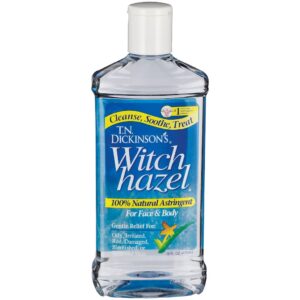
Despite the scary name, this ointment won’t hex you or turn you into a frog. Instead, witch hazel is often used topically to help treat wounds, much like rubbing alcohol.
Since witch hazel can be ingested with no side effects, it’s also an effective choice for treating wounds that children may have sustained.
Witch hazel is harvested naturally from trees, and it has no artificial ingredients that can potentially cause side effects.
Some of the main benefits of using witch hazel include the soothing of inflamed skin (something that rubbing alcohol also does) and the treatment of sensitive skin.
Its anti-inflammatory properties also make witch hazel a popular treatment for acne. In addition to being used topically, witch hazel can also be consumed orally to provide its many benefits.
- Product Type:Astringent Substance
- Item Package Dimension:4.292 cm L X8.712 cm W X18.491 cm H
- Item Package Weight:0.29 kg
- Country Of Origin: United States
Here are some other posts that might interest you:
- Are Surgical Spirit and Rubbing Alcohol the Same?
- Can Rubbing Alcohol Build Guitar Calluses?
- How To Make Your Own Disinfectant Spray With Rubbing Alcohol
- Detailing Your Car With Rubbing Alcohol
- Using Rubbing Alcohol As Hair Bleach

My name is Logan, and I’m a 36-year-old dad who owns a small pressure-washing company in the suburbs of Atlanta, Georgia. My main goal with rubbing-alcohol.com is to show you how versatile isopropyl rubbing alcohol can be! I hope. You find it useful.
We're an affiliate! We may earn a small commission when you make a purchase from product links at no additional cost to you!

